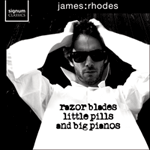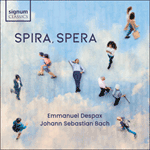
Welcome to Hyperion Records, a British classical label devoted to presenting high-quality recordings of music of all styles and from all periods from the twelfth century to the twenty-first.
Hyperion offers both CDs, and downloads in a number of formats. The site is also available in several languages.
Please use the dropdown buttons to set your preferred options, or use the checkbox to accept the defaults.

The ebb and flow of harmonic tension in the sombre Adagio from the violin sonata in F minor is realized by means of a scrupulously plotted dynamic graph that would be frowned upon today, yet it captures the inexorable unity of the piece to perfection. The inherently subjective nature of our cherished musicological objectivity surfaces in the Andante from the A minor solo violin sonata. Siloti clearly believes that he has treated Bach’s text with irreproachable fidelity and even adds an apologetic note for transposing a couple of bars down an octave. Yet from the moment we hear the sumptuously voiced chords cushioning Bach’s sublime melody we know that we are in the hands of a master romantic pianist. In the original Bach-Gesellschaft edition there was a (rather weak) keyboard transcription of the whole sonata, but later research has pronounced it spurious. The notion that it may be the work of one of Bach’s sons adds a little spice to the speculation. The same Wilhelm Friedemann Bach was the lucky recipient of the little Prelude in B minor which was brought to a wider public in the recording age through Emil Gilels’ unforgettable rendering. The tradition which brings into prominence the hidden left-hand melody in the repeat comes, according to Siloti’s daughter Kyrenia, from the master himself! The Siciliano from the flute sonata in E flat major has been the object of several piano transcriptions (Alkan, Kempff, Friedman and others) as well as suffering the indignity of issuing as muzak from countless elevators and hotel lobbies. Siloti’s, without attempting anything extraordinary, is in my opinion simply the best. In the famous Air from the third orchestral suite, he is again scrupulously respectful to Bach’s text, but his imaginative use of the pedal and the extraordinarily expressive fingerings are of a different epoch.
from notes by Hamish Milne © 2005
Dans le sombre Adagio de la Sonate pour violon en fa mineur, le flux et le reflux de la tension harmonique est atteint via une courbe dynamique scrupuleusement tracée qui ferait sourciller aujourd’hui, alors qu’elle saisit à la perfection l’inexorable unité de la pièce. La nature intrinsèquement subjective de notre chère objectivité musicale point dans l’Andante de la Sonate pour violon en la mineur. Silot, qui pense à l’évidence avoir été d’une fidélité irréprochable envers le texte de Bach, va jusqu’à ajouter une note d’excuse pour avoir transposé deux mesures à l’octave inférieure. Dès l’instant, pourtant, où nous entendons les accords somptueusement formulés, qui amortissent la sublime mélodie de Bach, nous savons que nous sommes entre les mains d’un maître-pianiste romantique. L’édition originale de la Bach-Gesellschaft recelait une transcription pour clavier (plutôt faible) de toute la sonate, mais des recherches ultérieures l’ont déclarée apocryphe. L’idée selon laquelle elle pourrait être l’œuvre de Wilhelm Fiedemann Bach ajoute un peu de piment à la spéculation. Ce même fils de Bach fut l’heureux récipiendaire du petit Prélude en si mineur qu’un plus large public découvrit, à l’ère de l’enregistrement, grâce à l’inoubliable interprétation d’Emil Gilels. La tradition consistant à mettre en avant la mélodie cachée à la main gauche (reprise) vient, à en croire Kyrenia, la fille de Siloti, du maestro en personne! La Sicilienne de la Sonate pour flûte en mi bémol majeur—ravalée au rang de fond sonore dans d’innombrables ascenseurs et halls d’hôtel—a fait l’objet de plusieurs transcriptions pour piano (Alkan, Kempff et Friedman, entre autres). Sans rien tenter d’extraordinaire, celle de Siloti est, à mon sens, tout simplement la meilleure. Dans le fameux Air de la Suite orchestrale no 3, Siloti respecte, de nouveau, scrupuleusement le texte de Bach, mais sons usage inventif de la pédale et ses doigtés extraordinairement expressifs sont d’une époque tout sauf bachienne.
extrait des notes rédigées par Hamish Milne © 2005
Français: Hypérion
Das Auf und Ab der harmonischen Spannung in dem ernsten Adagio aus der Violinsonate in f-Moll wird mit Hilfe eines genau ausgearbeiteten dynamischen Diagramms angezeigt, über das man heute lachen würde, doch gibt es die strenge Einheit des Werks nahezu perfekt wieder. Die inhärent subjektive Natur unserer in Ehren gehaltenen musikwissenschaftlichen Objektivität kommt in dem Andante der a-Moll Violinsonate zum Vorschein. Siloti ist offenbar überzeugt davon, dass er Bachs Notentext mit tadelloser Werktreue behandelt hat und fügt sogar eine kurze Bemerkung an, in der er sich dafür entschuldigt, dass er ein paar Takte eine Oktave herunter transponiert hat. Doch sobald wir die üppigen Akkorde hören, die Bachs erhabene Melodie polstern, ist es klar, dass wir uns in den Händen eines großen romantischen Pianisten befinden. In der ursprünglichen Ausgabe der Bach-Gesellschaft befand sich eine (recht schwache) Klavierbearbeitung der gesamten Sonate, doch wurde diese später für unecht befunden. Die Annahme, dass es sich dabei um das Werk eines Bachsohns handeln könnte, verleiht der Theorie noch mehr Würze. Derselbe, Wilhelm Friedemann Bach, war auch der glückliche Empfänger des kleinen Präludiums in h-Moll, das dank der unvergesslichen Aufnahme von Emil Gilels ein breiteres Publikum erhielt. Die Tradition, nach der die versteckte Melodie in der linken Hand in der Wiederholung hervorgehoben wird, stammt der Tochter Silotis, Kyrenia, zufolge vom Meister selbst! Das Siciliano aus der Flötensonate in Es-Dur ist nicht nur wiederholt für Klavier bearbeitet worden (von Alkan, Kempff, Friedman und anderen) sondern ist auch der Muzak zum Opfer gefallen und wird heute in zahllosen Aufzügen und Hotelrezeptionen gespielt. Silotis Version will nicht weiter hervorstechen und ist meiner Meinung nach doch einfach die beste. Das berühmte Air aus der 3. Orchestersuite behandelt er wiederum mit äußerster Texttreue, jedoch sind die ungewöhnlich expressiven Fingersätze und der phantasievolle Einsatz des Pedals deutlich von einer anderen Epoche.
aus dem Begleittext von Hamish Milne © 2005
Deutsch: Viola Scheffel
 Inside tracks - the James Rhodes mix tape Inside tracks - the James Rhodes mix tapeA selection of James Rhodes' personal favourites, tracks taken from his four earlier Signum albums.» More |
 Razor blades, little pills and big pianos Razor blades, little pills and big pianos'Razor blades, little pills and big pianos' explores the emotive landscape that we call 'life'. This debut recording is somewhat of a biographical expression of James Rhodes’s complex and unorthodox journey. It was Bach, Beethoven and Chopin; not ...» More |
 Spira, spera - Bach transcriptions Spira, spera - Bach transcriptionsThis virtuosic programme of Bach piano transcriptions combines tried-and-tested favourites—such as the mighty Bach-Busoni 'Chaconne' and Myra Hess's 'Jesu, joy of man's desiring'—with uncompromising first recordings of arrangements by Theodor Szán ...» More |

